What Is A Flax Egg And How Do You Make One?
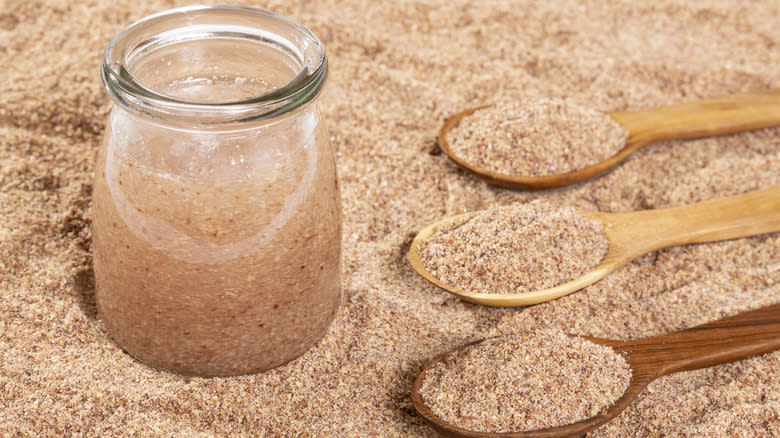
Flaxseed (Linum usitatissimum) is commonly used by many folks with specific eating habits, usually for its high fiber content. Smoothie drinkers add it to their blends, crunchy hippies use it in their bakes and salads, and those needing a boost for their bowels take it as a supplement. It contains essential Omega-3 fatty acids alongside various minerals like manganese and iron, making it a superfood of sorts. However, apart from its health benefits, vegans also use it as an egg replacement in baking, in a form known as "flax egg."
Folks who adhere to a vegan diet use many interesting ingredients and methods to replicate the properties of animal products in their cooking. To veganize a recipe usually requires the cook to figure out the taste and texture that needs to be simulated and how a particular ingredient acts as a bridge between other ingredients.
Eggs are one such ingredient, and we love using them in baking because they act as a binding agent, a sort of glue that contributes to the structure of many baked goods. Without eggs, the final product may be dense and crumbly. This is where flax eggs come in as a useful substitute, providing similar binding results as poultry eggs.
Read more: 14 Liquids To Add To Scrambled Eggs (And What They Do)
What Is A Flax Egg?
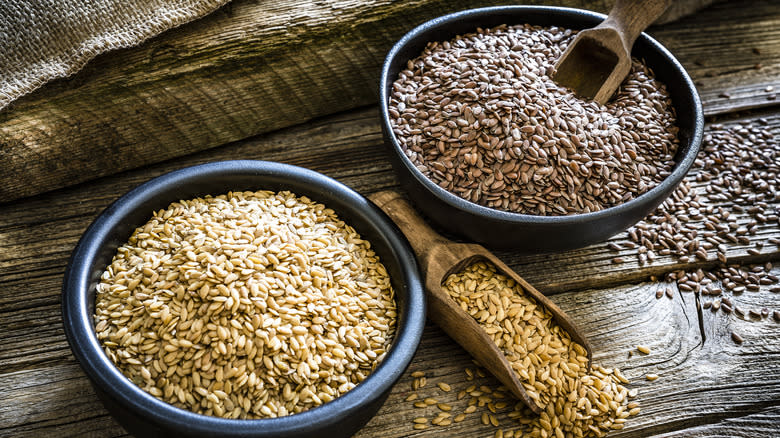
A flax egg is more or less what it says on the tin: an egg substitute made of ground flaxseed mixed with water. Whenever a baking recipe calls for one or two eggs, an equivalent volume of the flax egg at the appropriate viscosity (more on that later) is added to the batter. If the recipe calls for more than two eggs, say, a large amount of eggs for a pound cake, other substitutions are recommended as it then involves replicating properties of the egg beyond its binding abilities.
The ground flaxseed used to make flax eggs is made from flaxseeds, the most common and popular member of the Linaceae family, whose other members include various flowering vines and shrubs. Other uses for Linum usitatissimum include weaving the plant fibers into linen or pressed for its oil, after which the solids become animal fodder. Flaxseeds themselves come in two varieties: brown and yellow, or golden. The only real difference is in its color — golden flaxseed is used when the baker prefers not to have a speckled end product. As for size, flaxseeds are about twice the length of sesame seeds, though they appear more flattened.
How Flax Egg Is Made And How To Use It
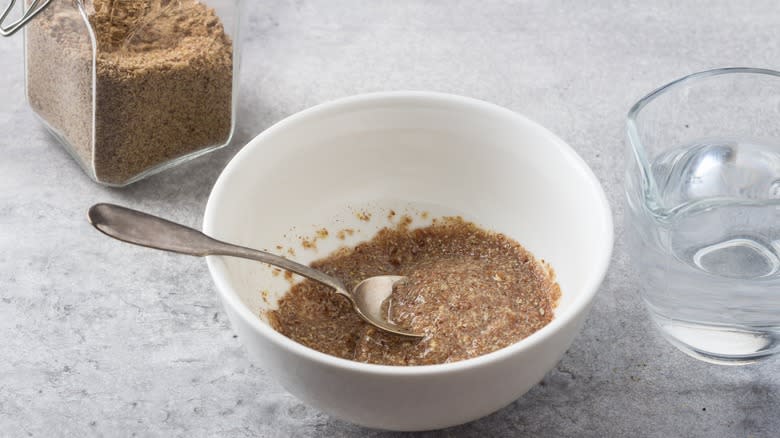
Flax egg is made by mixing one part ground flaxseed with three parts of hot water. It then sits for several minutes, turning into a thick, gel-like substance reminiscent of egg whites. Hot water is preferred to prepare flax egg, as cold water will require a much longer time to reach the required texture, up to 10 minutes or more. If all you have is cold water, you can mix a portion of flax egg at the start of your ingredient prep, and by the time you need to add it to the batter, it will have gelled. It is important to use ground flaxseed as it is much more absorbent in this form compared to whole flaxseed.
Do not worry about hot water or the heat of the oven altering the nutritional benefits of flaxseed, as research shows that it remains stable up to 350 degrees Fahrenheit, which happens to be the required oven temperature for many baking recipes.
How Does Flax Egg Work And How Does It Taste?
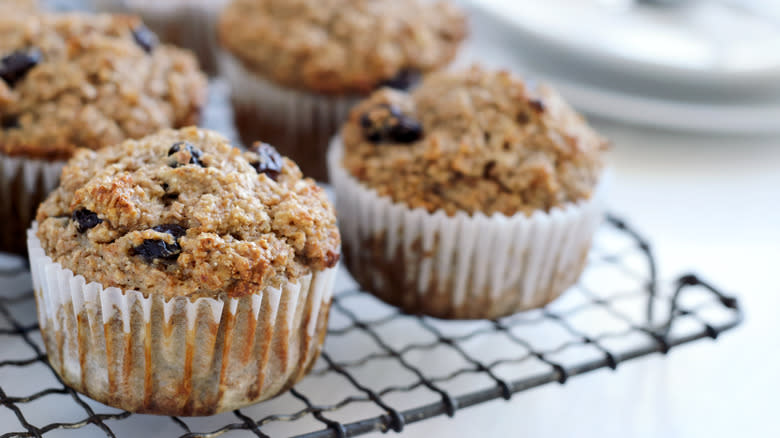
Flax egg's primary role in baked goods is to act as a binder for the ingredients, with the carbohydrates within the flaxseeds providing structure for other ingredients. It also can have a slight leavening effect when whipped, though it does not trap air quite as effectively as egg whites do, so it is not a good choice for choux pastry or sponge cakes, which require a lot of lift.
Additionally, flax egg is not recommended for recipes requiring a lot of eggs because it tends to absorb moisture from other ingredients. The more flax egg is added, the more the other ingredients dry out, which can result in dense and dry bakes. This may be compensated for by the addition of liquid by way of the water in flax egg, but it is still recommended for cookies and muffins, but not for brownies.
What about its taste? As it is a seed, it will impart a very faint nutty flavor, though it is virtually undetectable in small amounts. If you have a sensitive palate, this flavor can be camouflaged by other, stronger flavors like chocolate or celebrated by incorporating more nuts and seeds into the baked goods.
Flax Eggs Versus Eggs And Other Egg Substitutes
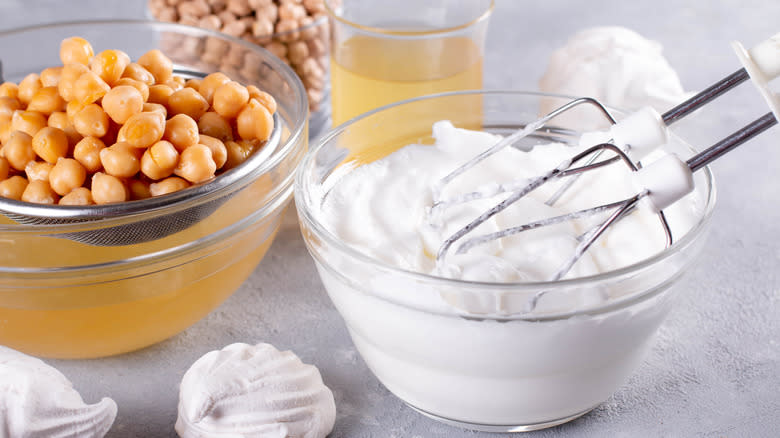
Before we get into the properties of different egg replacements, let us discuss the role of eggs in baking itself. Eggs are emulsifiers, helping to bind things together; they can be used to thicken and build volume; their viscosity makes them excellent at stabilization, and also adds richness in both taste and visual impact. When using an egg replacer, one has to consider which of these qualities they are trying to replicate. In the case of flax egg, it works well as an emulsifier. If you are unfortunately sensitive to flaxseed, chia seeds can be prepared in much the same way — one part ground chia seeds mixed with three parts water, and let sit until gelled — then used in the recipe in place of egg.
If it is lift that you are looking for, especially in the form of meringue, then look to aquafaba instead. This chickpea liquid whips up remarkably like egg whites and sets the same way as well. If you have a chickpea allergy, you can get similar results with flaxseed, though with a little bit more work. Start by boiling whole flaxseeds in water, then continue cooking at a simmer until it reaches the familiar gelled consistency of flax eggs. Strain the seeds off and whip this thick liquid into a meringue as you would aquafaba or egg whites.
Where To Buy And How To Store Flax Egg
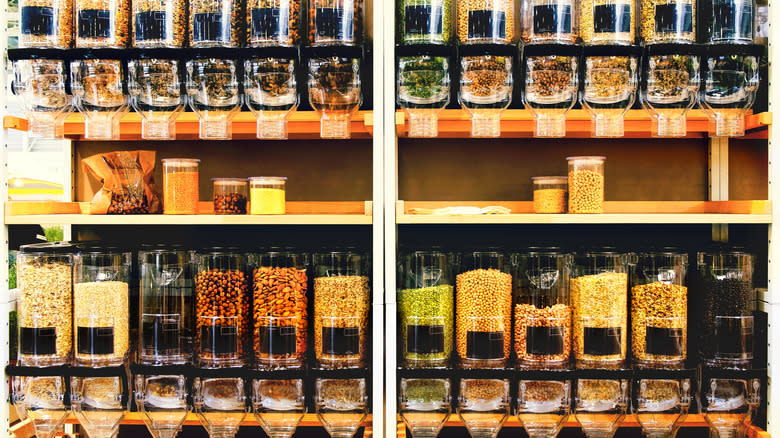
Flaxseed is available at grocery stores and health food stores. Look for it in the same aisle as other nuts and seeds or in the baking section. If the store has a specific vegan or vegan baking section, chances are even better that you will find whole or ground flaxseed there. It is also possible to find flaxseed in the same section of the drugstore where the nutritional supplements are located, thanks to its high fiber content.
If you purchase whole flaxseed, store it in an airtight container out of direct heat and sunlight. Using a clean coffee or spice grinder, grind only as much as you need for the recipe, as the high amount of oils in flaxseed means that it will go rancid quickly in its ground form. If you have purchased ground flaxseed, storing it in the freezer will greatly extend its shelf life.
Read the original article on Daily Meal.

